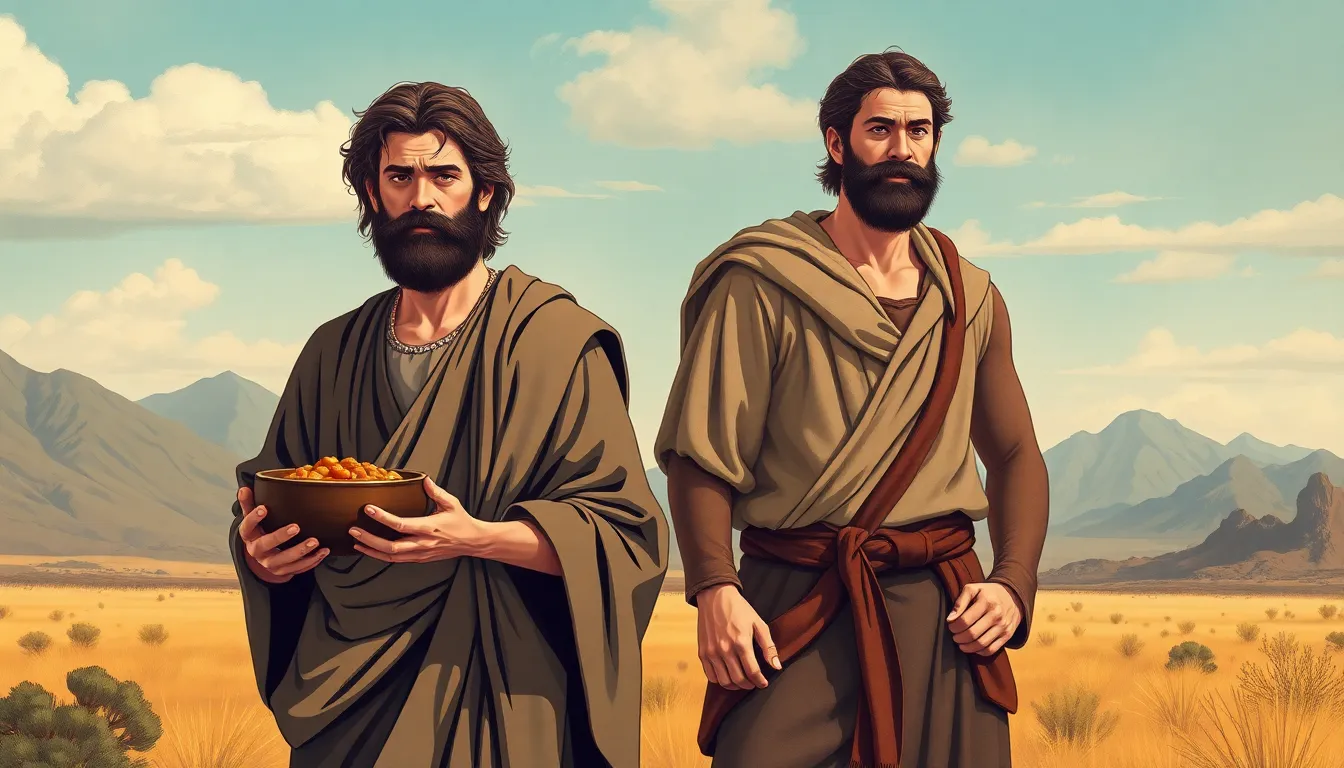Table of Contents
ToggleIn the grand tapestry of biblical tales, the story of Jacob and Esau stands out as a riveting saga of rivalry, redemption, and a dash of sibling rivalry that could put any reality show to shame. Picture this: two brothers, one hairy and rugged, the other smooth and crafty, each vying for their father’s blessing like it’s the last slice of pizza at a party.
This timeless narrative explores themes of family dynamics, deception, and the age-old question of who really gets the last word—or in this case, the last blessing. As they navigate their tumultuous relationship, readers are treated to a blend of humor and drama that highlights the complexities of human nature. Buckle up for a journey through a story that’s not just ancient history but a relatable tale that still resonates today.
Overview of the Story of Jacob and Esau
Jacob and Esau, twin brothers born to Isaac and Rebekah, embody contrasting traits that set the stage for their rivalry. Esau, the elder, possesses a rugged demeanor and excels in hunting. Jacob, on the other hand, displays a thoughtful nature and favors life indoors. Their differences spark a complex relationship marked by tension and competition.
The narrative unfolds with Esau returning from the fields, famished and desperate for food. In a moment of impulsiveness, he trades his birthright to Jacob for a simple meal, highlighting the theme of short-term cravings over long-term benefits. This exchange lays the groundwork for their future conflicts and sets a tone of betrayal.
Later events depict Jacob using deception to secure Isaac’s blessing meant for Esau. Disguised in goat skins, Jacob tricks his blind father into believing he’s Esau. Such actions emphasize not only Jacob’s cunning but also the impact of parental favoritism, as Rebekah favors Jacob over Esau. These family dynamics amplify the story’s tension, illustrating how manipulation and ambition interfere with familial harmony.
Upon discovering the betrayal, Esau vows revenge and reacts with intense rage. His response demonstrates the depths of sibling rivalry, suggesting that familial bonds can fracture under pressure. Consequently, Jacob flees to escape Esau’s wrath, marking a significant turning point. This journey of avoidance represents his struggle for identity and acceptance.
The narrative not only captivates with its drama, but also provides insights into human behavior. The story portrays how jealousy and competition influence relationships, fostering discussions about sibling dynamics that remain relevant today. This ancient account continues to resonate, making the tale of Jacob and Esau an enduring exploration of family complexities.
Key Characters and Their Roles

This section highlights the key figures in the story of Jacob and Esau, focusing on their distinctive traits and roles in the narrative.
Jacob: The Deceiver
Jacob stands out as a complex character whose actions shape much of the story. He demonstrates shrewdness from an early age, particularly evident when he trades a simple meal for Esau’s coveted birthright. Deception becomes a defining theme in his life, especially as he disguises himself to steal his brother’s blessing, an act fueled by his mother’s favoritism. While Jacob’s cunning often incites conflict, it also ignites a quest for self-identity and acceptance. His journey reveals the consequences of his actions, revealing the challenges of living with guilt and betrayal. Ultimately, Jacob’s character evolves, reflecting on the depth of his choices.
Esau: The Forgiving Brother
Esau, in contrast, embodies resilience and strength. As the eldest son, he initially accepts his role and abilities tied to survival, excelling in hunting and outdoor life. His impulsive nature prompts him to trade his birthright, showcasing a lack of foresight. Despite his initial anger over Jacob’s betrayal, Esau’s character reveals a capacity for forgiveness and transformation. When Jacob returns after years apart, Esau’s warm embrace symbolizes reconciliation over revenge. This moment highlights the strength of familial bonds, illustrating his growth beyond anger. Esau’s journey emphasizes the themes of humanity and redemption, showcasing empathy amid rivalry.
Major Themes in the Story
The story of Jacob and Esau offers numerous themes that resonate within family relationships and individual choices.
Family Dynamics and Rivalry
Family dynamics play a crucial role in shaping the rivalry between Jacob and Esau. Their contrasting traits lead to tension and conflict, highlighting how favoritism impacts sibling relationships. Rebekah’s preference for Jacob intensifies the competition for parental approval. Esau embodies rugged strength, while Jacob’s cunning reflects his desire for acceptance. Moments of betrayal deepen the divide, showcasing how differing values can create lasting rifts. The intense emotions experienced by both brothers illustrate the complexities of familial bonds. Their interactions reveal the struggle for identity and love within a family setting.
The Concept of Birthright and Blessing
The concept of birthright and blessing serves as a central element in their rivalry. Esau’s impulsive trade of his birthright for a meal illustrates the dangers of short-term desires overshadowing long-term consequences. This transaction sets a stage for future conflicts fueled by feelings of betrayal. Jacob’s deception in securing Isaac’s blessing emphasizes the significance of these familial legacies. Blessings hold weight in shaping identity and inheritance. Esau’s furious reaction to losing his birthright and blessing showcases the emotional stakes involved. Ultimately, these concepts highlight themes of value and sacrifice in the pursuit of familial connections.
Interpretations and Symbolism
The story of Jacob and Esau offers rich interpretations and profound symbolism in various contexts.
Religious Significance
Within religious contexts, Jacob and Esau’s narrative highlights themes of divine choice and redemption. Their complex relationship underscores God’s sovereignty in choosing Jacob as the bearer of the covenant despite his deceptive actions. The implications extend to discussions of God’s grace and mercy, showing that individuals can seek forgiveness regardless of their past. Esau’s portrayal, although considered impulsive, reflects the importance of redemption and reconciliation in faith. This story encourages reflection on family dynamics, divine favor, and the moral implications of choices.
Cultural Impact
Culturally, Jacob and Esau’s rivalry resonates through literature and art, symbolizing the enduring struggle between opposites. The narrative’s themes find expression in various works, showcasing sibling rivalry and its consequences across generations. Many cultures reference the tale to explore notions of identity, competition, and forgiveness. Popular media has also adapted these themes, transforming them into contemporary discussions about relationships and family dynamics. Their story serves as a timeless reminder of the complexities inherent in human interactions, prompting discussions relevant to modern audiences.
The story of Jacob and Esau stands as a powerful exploration of familial bonds and the complexities of sibling rivalry. Their contrasting personalities and choices reveal deep truths about human nature and relationships. Jacob’s cunning and Esau’s resilience highlight the lengths individuals go to seek approval and identity within their families.
As the narrative unfolds, it emphasizes the importance of forgiveness and understanding, showcasing how even the deepest rifts can be healed. This timeless tale resonates with audiences today, reminding them of the ongoing struggles and triumphs in familial relationships. The lessons learned from Jacob and Esau continue to inspire conversations about empathy, redemption, and the intricate dynamics that shape family life.




